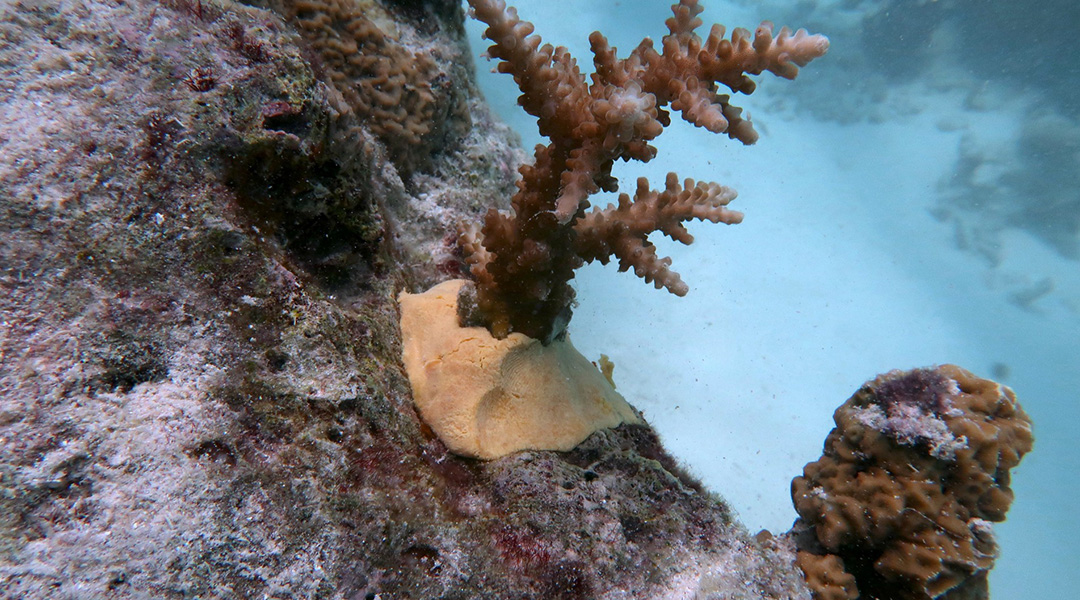Restoring coral reefs could soon be much easier thanks to an easy-to-use, biodegradable putty used to secure coral fragments to reef rock, allowing the transplantation of new coral colonies. The quick-hardening putty, which can be mixed underwater, is the first product specifically formulated with coral reefs in mind.
For the past ten years, marine biologists from the University of Milano-Bicocca in Italy have been working to preserve these vulnerable ecosystems at the Marine Research and Higher Education Center, a research outpost in the Maldives established by scientists at the university.
“In the last few years, several coral nurseries have been built and maintained, and there are abundant colonies ready for transplantation, making the reef around the island the ideal setting for our research,” said Marco Contardi, an assistant professor at the University of Milano-Bicocca and affiliated researcher at the Italian Institute of Technology who was involved in the project.
Coral reefs provide homes for a huge number of other sea creatures, including crabs, fish, and a host of other sea creatures. But their existence is being threatened by changing ocean conditions brought about by climate change, pollution, and overharvesting.
“Especially [in recent] last months, the rise in sea temperature caused by the El Niño phenomenon has triggered an incredibly severe bleaching event that is destroying reefs not only across the entire archipelago but also worldwide,” said Jacopo Gobbato, a marine biologist and Ph.D. student working on the project.
Unlike commercial epoxy-based putties typically used for coral restoration, the putty Contardi, Gobbato, and their team developed is specifically made for transplanting corals to a restoration site.
For example, the products IamSub and Aquamend are designed for household repairs or protecting offshore steel and concrete structures and come with risks. They contain compounds that could potentially harm marine life and persist as pollutants in the ocean, whereas the newly developed coral putty is made entirely of environmentally benign, biodegradable ingredients.
A coral safe putty
To make the first component of the putty, the research team combined soybean oil, zein — which acts as a filler material to give the right consistency to the paste — and a compound that initiates the hardening reaction in one container.
In a separate container, they mixed soybean oil, zein, and a compound that accelerates the reaction. They blended these two mixtures into pastes and stored them separately until the time of application.
“The recipe is easy and not time-consuming,” said Contardi. “You need modified soybean oil, the protein zein [derived from corn], and a chemical initiator and accelerator.”
The hardening reaction is triggered when the two mixtures are combined, generating unstable, reactive chemical species called radicals, explained Arkadiusz Zych, a postdoctoral researcher at the Italian Institute of Technology.
These radicals rapidly react with the modified chains in the soybean oil’s structure to stabilize themselves, forming new bonds in the process. The rate of this reaction can be controlled by changing the amounts of initiator and accelerator, allowing the hardening time to be customized.
“The formation of these new bonds among the fatty acid chains of the soybean oil immobilizes the matrix structure, and this is the reason why the material starts hardening,” Contardi explained. The paste hardens in just 20–25 minutes, much faster than IamSub and Aquamend, which take over two hours.
Underwater coral reef tests
To validate the putty’s safety and performance, Contardi and his team used it to attach small coral fragments called nubbins to supports made from different materials in the Aquarium of Genoa.
These initial results were promising, so they scaled up their approach, testing the putty at a field site near their research center on Magoodhoo Island in the Maldives. They chose a sheltered lagoon to out-plant five colonies of the fast-growing coral species, Acropora tenuis.
Their approach, known as coral gardening, involves nurturing coral fragments collected from the seabed or donor colonies under controlled artificial conditions, and then transplanting the healthy coral to the target site.
Transplantation, the process of attaching coral to the reef, is a crucial step in the restoration process, said Valerio Isa, a marine biologist and postdoctoral researcher at the University of Milano-Bicocca. “This period is critical because the coral begins to grow and stabilize on the substrate.”
At the field site, the researchers dove underwater to the reef rock, first brushing it clear of algae, sand, and sediment. Then, they hand mixed the two components of the putty for around one minute, applied it to the rock, and attached the coral to the putty, molding the putty around the base of the coral. After performing a “wave test” — waving water by hand nearby to ensure that the coral was securely planted — they moved onto planting the next colony.
The researchers found that after 12 months, the out-planted coral had remained firmly in place and had grown naturally, without interference from the putty.
The putty is not yet commercialized, but Contardi plans to patent their product and eventually bring it to the market, making it accessible to both experts and newcomers in the field.
“We are already working on new prototypes of our putty in order to improve its performance in several aspects, such as mechanical and ecological, to expand its application on other coral species that can be softer or heavier,” he shared.
Coral restoration projects have become increasingly important in recent years, and Contardi believes the putty could help unify these efforts.
“Our testing in the Maldives aligns perfectly with these efforts to give time to the reefs to recover and withstand the challenges they are facing,” he commented.
Reference: Arkadiusz Zych, Marco Contardi, Athanassia Athanassiou, Simone Montano, et al. Underwater Quick-hardening Vegetable Oil-based Biodegradable Putty for Sustainable Coral Reef Restoration and Rehabilitation, Advanced Sustainable Systems (2024). DOI: 10.1002/adsu.202400110
Feature image credit: Arkadiusz Zych, et al.

















